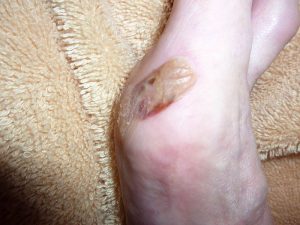A growing redness of the skin can often signal the beginning of a much more unpleasant condition – painful blisters.
Blisters are fluid-filled sacs that resemble fleshy bubbles on the surface of the skin. They most commonly appear on the feet as the result of friction from shoes that don’t fit properly. If the fluid sack is ruptured, blisters can become infected and begin to form pus, thus making the already lingering issue even more difficult to deal with.
There are many causes of blisters, including:
Irritation: One of the most common causes of blisters is skin irritation caused by friction or exposure to extreme cold (frostbite) or heat (sunburn). In some other cases, blisters are caused by irritation from contract with certain chemical and could eventually lead to dermatitis.
Allergies: Allergic contact dermatitis, a form of dermatitis or eczema, may result in blisters. Allergic contact dermatitis is caused by an allergy to a chemical or poison. The majority of these poisons are found commonly in nature in plants like poison ivy and poison oak.
Infections: Infections that cause blisters include bullous impetigo, an infection of the skin caused by staphylococci bacteria; viral infections of the lips and genital area due to the herpes simplex virus chickenpox and shingles, which are caused by the varicella zoster virus.
Skin diseases: There are several skin diseases that can cause blisters, including herpetiformis, pemphigoid and pemphigus. There also are inherited forms of blistering skin conditions, such as epidermolysis bullosa.
Luckily, most blisters don’t require medical treatment and can be handled in the comfort of your own home. The first step is to protect the irritated area as soon as you see signs of redness — also known as “hot spots” — that signal an oncoming blister.
How to Treat Painful Blisters
If a full-fledged blister does form, however, you can follow these steps:
1. Clean your hands and fingers with antibacterial soap.
2. Sterilize a needle by holding it over a flame until it is red hot and then rinse it with alcohol.
3. Using the sterilized needle, make a small hole on the side of the blister and gently drain the blister of the fluid by applying pressure.
4. It is important to keep the remaining loose skin in place as it will not only help the area heal faster, but also reduce the risk of infection.
5. Apply antibiotic ointment or clean your skin with a sterilizing-wipe and cover the area with gauze or a gel dressing.
Warning: If the fluid that comes out of the blister is white, yellowish, or greenish, then that is a sign that your blister could be infected. If you experience these symptoms, see a doctor immediately to get the infection under control.
—
Follow Delray Beach Podiatry on Twitter @Delray_Podiatry
The content on this website is for informational purposes only. Do not rely or act upon information from www.DelrayBeachPodiatry.com without seeking professional medical advice. If you live in South Florida and would like a consultation with Dr. Ian Goldbaum, a podiatric physician and surgeon with over 30 years of experience, please see our contact information below:
BOCA/DELRAY
16244 S. Military Trail #290, Delray Beach, FL 33484
561-499-0033
BOYNTON BEACH
8198 Jog Road #100, Boynton Beach, FL 33472
561-499-0033


No responses yet